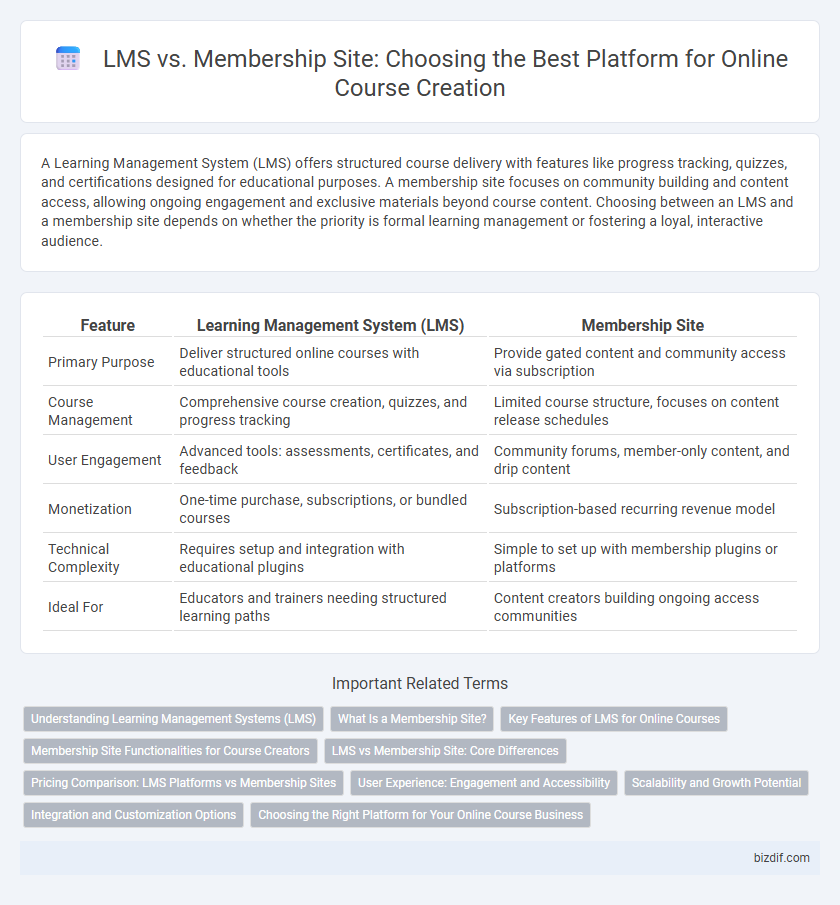A Learning Management System (LMS) offers structured course delivery with features like progress tracking, quizzes, and certifications designed for educational purposes. A membership site focuses on community building and content access, allowing ongoing engagement and exclusive materials beyond course content. Choosing between an LMS and a membership site depends on whether the priority is formal learning management or fostering a loyal, interactive audience.
Table of Comparison
| Feature | Learning Management System (LMS) | Membership Site |
|---|---|---|
| Primary Purpose | Deliver structured online courses with educational tools | Provide gated content and community access via subscription |
| Course Management | Comprehensive course creation, quizzes, and progress tracking | Limited course structure, focuses on content release schedules |
| User Engagement | Advanced tools: assessments, certificates, and feedback | Community forums, member-only content, and drip content |
| Monetization | One-time purchase, subscriptions, or bundled courses | Subscription-based recurring revenue model |
| Technical Complexity | Requires setup and integration with educational plugins | Simple to set up with membership plugins or platforms |
| Ideal For | Educators and trainers needing structured learning paths | Content creators building ongoing access communities |
Understanding Learning Management Systems (LMS)
Learning Management Systems (LMS) are specialized platforms designed to deliver, track, and manage online courses efficiently. Unlike membership sites, LMS platforms provide structured course content, assessments, and detailed analytics to monitor learner progress. Key features include modular content delivery, quiz integration, certification tracking, and seamless user management tailored for educational experiences.
What Is a Membership Site?
A membership site is an online platform that provides exclusive access to content or services through subscription-based membership tiers, often supporting community interaction and ongoing engagement. Unlike Learning Management Systems (LMS) primarily designed for structured course delivery and tracking, membership sites emphasize building a loyal audience with continuous access to resources, forums, and special offers. This model is ideal for creators seeking recurring revenue and sustained member interaction beyond traditional course frameworks.
Key Features of LMS for Online Courses
Learning Management Systems (LMS) offer robust features such as course authoring tools, progress tracking, and quiz integration designed specifically for structured online course delivery. Unlike membership sites, LMS platforms provide detailed analytics on learner engagement, certification management, and seamless content drip scheduling to enhance the educational experience. These capabilities make LMS essential for educators seeking efficient course management, personalized learning paths, and comprehensive assessment tools.
Membership Site Functionalities for Course Creators
Membership sites offer comprehensive tools for course creators, including content gating, subscription management, and integrated community features that enhance learner engagement. Unlike traditional LMS platforms, membership sites provide flexible access models such as pay-per-course, tiered memberships, and drip content delivery to maximize recurring revenue. Advanced analytics and built-in marketing automation further empower creators to optimize retention and personalize the learning experience.
LMS vs Membership Site: Core Differences
Learning Management Systems (LMS) are specialized platforms designed to deliver, track, and manage educational courses with features like quizzes, progress tracking, and certifications. Membership sites primarily focus on content access control and community building, often providing gated content and subscription management without advanced course management tools. The core difference lies in LMS's structured, pedagogical approach to e-learning versus membership sites' emphasis on exclusive content delivery and member engagement.
Pricing Comparison: LMS Platforms vs Membership Sites
Learning management systems (LMS) typically charge based on the number of users or courses, with prices ranging from $30 to $300 per month, offering scalable solutions for formal education and corporate training. Membership sites often use flat-rate pricing or tiered subscriptions, generally costing between $20 and $150 monthly, focusing on community access and recurring content delivery. Comparing costs, LMS platforms may become expensive as user counts grow, while membership sites provide more predictable expenses suitable for creators prioritizing ongoing member engagement.
User Experience: Engagement and Accessibility
A Learning Management System (LMS) offers a structured and interactive platform designed to enhance user engagement through features like quizzes, progress tracking, and multimedia content that cater to diverse learning styles. Membership sites prioritize accessibility by providing flexible, on-demand access to course materials, fostering a community atmosphere through discussion forums and exclusive member content. Choosing between an LMS and a membership site depends on the balance of engagement tools versus ease of access preferred by the target audience.
Scalability and Growth Potential
Learning Management Systems (LMS) offer robust scalability features designed to support large numbers of users and diverse course content, making them ideal for educational institutions and growing businesses. Membership sites provide flexible growth potential by combining content access control with community-building tools, enhancing user engagement and recurring revenue streams. Choosing an LMS is optimal for structured learning experiences requiring advanced tracking, while membership sites excel in fostering long-term customer relationships and scalable subscription models.
Integration and Customization Options
Learning Management Systems (LMS) offer extensive integration capabilities with third-party tools such as assessment software, CRM platforms, and payment gateways, enabling seamless course delivery and management. Membership sites provide flexible customization options for branding, access controls, and member engagement features, often through plugin compatibility and theme adjustments. Choosing between LMS and membership sites depends on the need for specialized educational features versus community-building and content access customization.
Choosing the Right Platform for Your Online Course Business
Choosing the right platform for your online course business depends on your goals and audience engagement needs. Learning Management Systems (LMS) offer structured course delivery, progress tracking, and assessment tools ideal for comprehensive educational programs, while membership sites provide ongoing community access and exclusive content for subscription-based models. Evaluate factors like ease of use, customization options, integration capabilities, and pricing to ensure the platform aligns with your business model and enhances learner experience.
Learning management system (LMS) vs Membership site Infographic

 bizdif.com
bizdif.com